View current page
...more recent posts
1987 - Chris Burden's All the Submarines of the United States of America
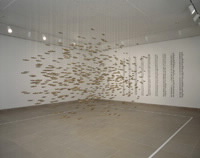
2006 - Fiona Banner's Parade
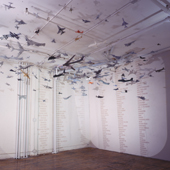
Thanks to Sally McKay for making me aware of Banner's collection of modeled fighter aircraft from all over the world, which will be shown soon in Toronto. It's the latest in our ongoing "attack of the clones" series.
Updated re: installation schedule.
"Tesseract Farm" [mp3 removed]
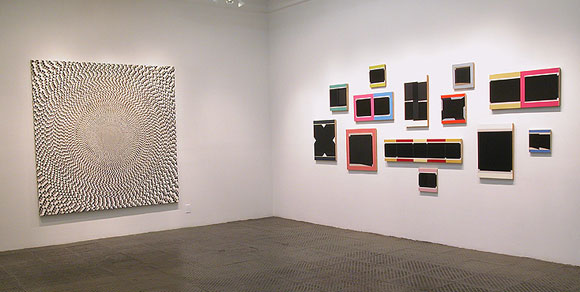
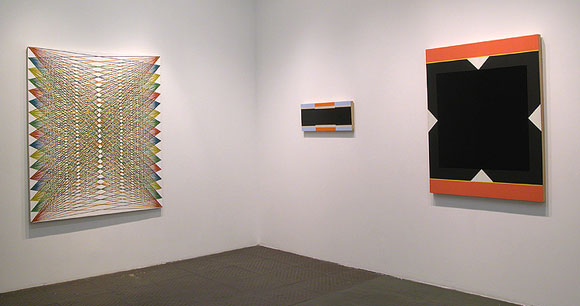
I am going to see this show later today--Mark Dagley (left images) and Don Voisine (right images) at McKenzie Fine Art, 511 West 25th Street in Chelsea. It's the last day of the exhibit, sad to say. An earlier post on Dagley is here. This current show with Voisine is reviewed in the New York Sun--nice, but I wouldn't stop with physical analysis of the work. Doesn't it look like Voisine is censoring his own paintings?
Update: one invigorating thing about the Dagleys in person is the Stella-esque what-you-see-is-what-you-see quality. The bottom one has a white ground and each line is a thick painted stripe connecting two points. The top one is thousands of circles drawn by hand in pencil and then filled in. It's a weird combination of cabalistic arcana, prison art, and the Bauhaus. As much as I enjoyed Marc Handelman's show at Sikkema Jenkins (a Bleckneresque young Turk out of Columbia who has all the advantages of art world virginity) it seemed flashy and overeager to please compared to Dagley's work, which is dazzling yet unassuming, and not as conservative as our two world weary critics might consider it (you know who I mean). As for the Voisine, Mark used the word redaction in the comments and that is the first thing the black bars bring to mind, even though in person you see a play of edges and surfaces in all those blacks. I'm personally not uncomfortable with references to office/bureaucratic culture in art and feel like the self-cancellation of those Xs and black bars gives the work an interesting psychological edge, though it was probably not intended--the paintings are handsome and thoughtful but serious about the rhetoric of painting.
The panelists for an upcoming College Art Association discussion on "Emerging Artists, Critics, and the Market" are Jeffrey Deitch, Don and Mira Rubell, Peter Plagens, and Jerry Saltz. According to an email from AICA, the critics' association organizing the event at the Hilton on Feb 17, among the questions to be addressed are:
In the current situation what, indeed, is the criticís role and responsibility? Are there opportunities? Are there ways to respond and to act that circumvent the conventions of build-a-reputation/trash-a-reputation? What is the relationship between collectors and dealers? How does it work? Why do art world systems go unanalyzed and uncritiqued by most critics? Is there room for critics to deepen the discourse? If so how? Does it make a difference if critics expose the issues within the market, art-making and criticism? Is anyone listening? Can dealers, collectors and artists listen to critics or only to one another? Is there anything critics learn from collectors and dealers? Does it matter? Are artists so caught up in the dazzle and anxiety of early success that they canít hear what they have to know or should a critic attempt to reach them with reasoned argument?
I quit going to these types of panels after a prominent critic told me "we can't discuss specific artists because collectors will rush out and buy them up." Here is an alternative set of questions:
1. What new forms of art have emerged since the '70s? Who are the best artists working today?
2. Have we had a "brain drain" in the art world since the days when Leo Steinberg, Rosalind Krauss, and Craig Owens wrote about their contemporaries (i.e. since about 1982)?
3. Is the art world's dedication to a relative handful of canonical (i.e., marketable) artists comparable to the "copyright tyranny" of Disney and other large corporations?
4. Won't blogging and other forms of online writing largely replace print criticism in the near future? (The publisher of the New York Times seems to think so.) How will that change art practice?
Update: Added Timesman's prognostication and link.
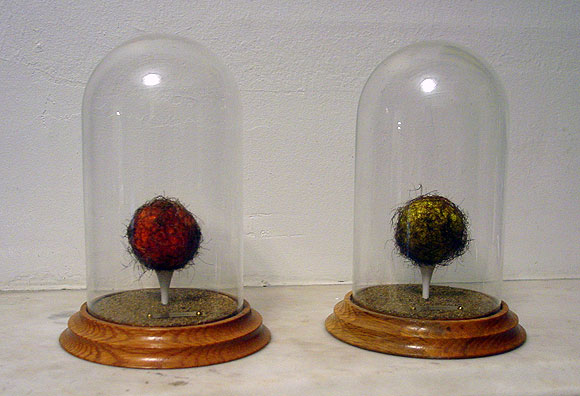
A work from my personal collection: The Art Guys' Goatee Off, ca. 1990. It's documentation of a performance piece where the Houston-based artists grew goatees and played a round of golf, shaving bit by bit as a way of keeping score (go tee off, get it?). Their beard hair is what you see glued to the golf balls. Meret Oppenheim, drink your tea.
Continuing our Art Guys series, this is a review I wrote for Art Papers when I lived in Texas and never sent in because I couldn't make it work...until today. It's a bit late for the magazine's deadline so here it is online:
"Jets," by The Art Guys
Dallas Museum of Art, November-December 1991
The main concourse of the Dallas Museum of Art ascends in a series of broad, gently sloping ramps, creating spaces reminiscent of airport architecture. Appropriately, that's where the Art Guys placed their installation Jets during the 1991 Dallas Video Festival.
Sixteen TV monitors fanned across the ceiling over the ramps, linked by black cables to a neat bank of VCRs on the wall. Each monitor faced down with its back securely bolted to the ceiling--or so we hoped. The screens glowed pale blue, green, or violet, the ambient colors of footage taped from the sky at different times and places, and intermittently roared to life as an airplane passed across the screen.
The artists phased the tapes so at a given time some screens showed empty sky and others tracked commercial aircraft landing or taking off in wobbly, hand held fields of view. The random distribution of the zooming images along the corridor kept the viewer off guard: as you followed the progress of one jet, another would loom unexpectedly behind you.
The network of cables crawling across the ceiling and down the wall to a controlling ganglion could emblematize the global transportation and communication systems on which we are so dependent, while the fragility of the systems could be felt in the nervous-making Damoclean placement of the monitors. That's one level of interpretation.
Yet sitting beneath them for a few minutes revealed something a hurried passerby might have missed: their curious kinship to natural phenomena. The random lightening and darkening of screens and the antiphonal whining of the jets became paradoxically calming, like stars blinking or insects chittering in the breeze. Thus do our daily threats become reassuring background texture.
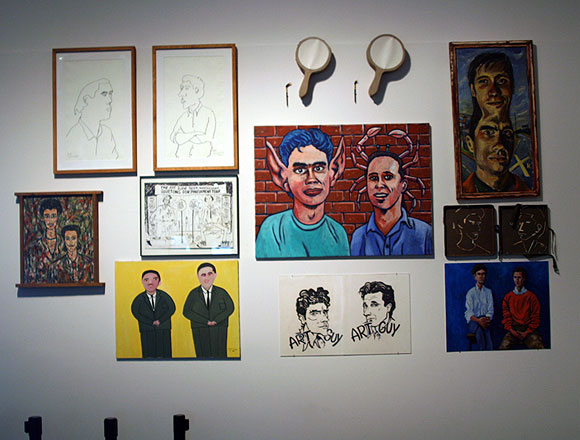
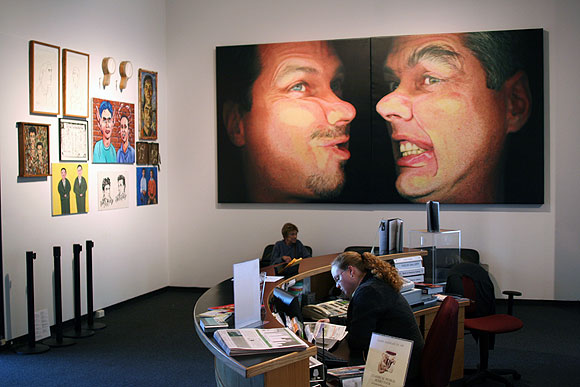
Third installment in The Art Guys series, these are photos from their current survey exhibition at the Tampa Museum of Art. The cluster of portraits originally came from a show they did in '90 called "See Through Us," an open call where other artists were invited to render them in various media. As a participant I tried to be as thift store painting-like as I could, hence my canvas of Michael Galbreth with oversized Mr. Spock ears and Jack Massing with crab appendages sprouting from his head (look, I'm in a museum now!). Although the painting above and to the right of it with Jack's face growing like a wen from Michael's forehead is far more successfully "thrifty." The tasty installation of these paintings is by Jade Dellinger, who curated the show. On the right in the lower photo is Smushed Faces, 2000, printed vinyl.
























































































Mood Ring, 2007, GIFs, HTML
Not intended for RSS readers.
